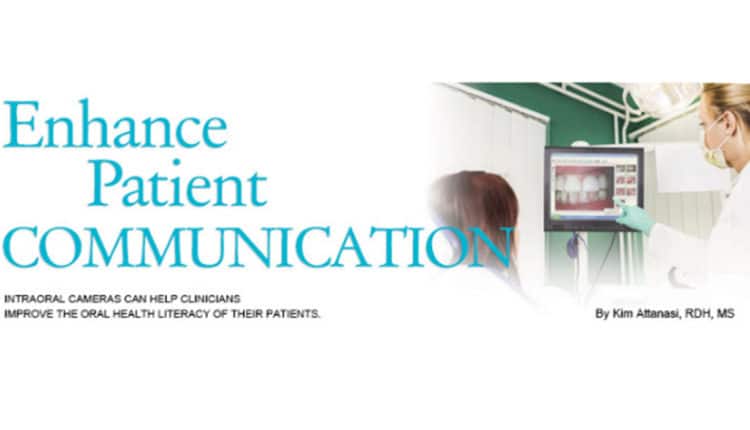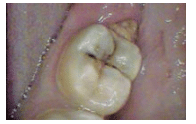
Enhance Patient Communication
Intraoral cameras can help clinicians improve the oral health literacy of their patients.
Effective communication between dental hygienists and patients has long been recognized as an important component of quality oral health care.1 Clinicians who focus on patients as people, instead of their health problems and management, will be much more successful in improving treatment outcomes and patient compliance.2 Effective patient-provider communication helps to increase case acceptance, fosters clinician trust, and improves patient retention rates and oral health literacy.3
ORAL HEALTH LITERACY
Approximately 90 million American adults are health illiterate—defined as the impaired capacity to obtain, process, and understand the basic health information and services needed to make appropriate health decisions.2,4 In addition, data from the 2011 American Community Survey show that 20.8% of those living in the United States do not speak English, which can impede patient-clinician communication.5 These barriers can make it difficult to discuss dental treatment options and provide proper oral hygiene education. Organizations, including the US Department of Health and Human Services, are urging health care providers to use an expanded set of techniques and tools to help educate patients and address their individual needs.6
VISUAL LEARNING

The use of pictures is essential for improving oral health literacy.7 It is widely reported that approximately 65% of people are visual learners. This type of learner absorbs information best when it is presented in a written format, including notes, diagrams, and pictures. An image helps patients understand and remember details and ideas,8 making visual aids an imperative tool for oral health professionals when discussing dental treatment or self-care.
THE ROLE OF INTRAORAL CAMERAS
Intraoral cameras are powerful tools in the patient education armamentarium. They transfer magnified digital images from the oral cavity onto a screen that is viewable by patients. The pictures are then stored and saved using digital imaging software.

Intraoral camera images enable patients to better understand their health status and treatment needs—facilitating communication between the dentist, dental hygienist, and patient. The magnification enables patients to view details of their specific conditions that would not otherwise be visible or easily understood (Figure 1). The images have a multitude of uses. They can be printed out so patients can take home to show family members, used to monitor oral lesions for any changes (Figure 2), and implemented to aid communication with a referring specialist.9
In patient education, providing patients with the ability to see inside their mouths may make them more apt to listen to instructions provided by an oral health professional and more likely to discuss treatment options. Radiographs are also key visual aids, but they are not simple enough for patients to understand. Patients often find it easier to relate to images of “real teeth.”
Through the use of intraoral photographs, clinicians can build trust, promote understanding, and motivate patients to improve their oral health. Well-informed patients are better positioned to accept the recommended treatment, comply with self-care recommendations, and seek care when future oral health issues arise.10
CONCLUSION
In today’s dental practice, the majority of patients will present with limited oral health literacy. Dental hygienists are charged with educating patients about their oral health status and dental needs in order to promote desired behavior changes, such as improved oral hygiene. Intraoral cameras are key tools in the patient education process. Increasing patients’ oral health literacy improves their understanding of the dental care they need. Educated patients are more likely to commit to and comply with treatment, which will have a lasting impact on their oral health.
REFERENCES
- Rozier RG, Horowitz AM, Podschun G. Dentist-patient communication techniques used in the United States: the results of a national survey. J Am Dent Assoc. 2011;142:518–530.
- Sondell K, Söderfeldt B. Dentist-patient communication: a review of relevant models. Acta Odontol Scand. 1997;55:116–126.
- Belzer EJ. Improving patient communication in no time. Fam Pract Manag. 1999;6:23–28.
- United States Centers for Disease Control and Prevention. Healthy People 2010: Understanding and Improving Oral Health. Available at: cdc.gov/nchs/data/hpdata2010/hp2010_final_review_focus_area_21.pdf. Accessed June 26, 2014.
- United States Census Bureau. American Community Survey. Available at: census.gov/acs/www. Accessed June 26, 2014.
- National Center for Education Statistics. The Health Literacy of America’s Adults: Results from the 2003 National Assessment of Adult Literacy. Available at: nces.ed.gov/pubs2006/2006483.pdf. Accessed June 12, 2014.
- United States Department of Health and Human Services. National Action Plan to Improve Health Literacy. Available at: health.gov/communication/hlactionplan/pdf/Health_Literacy_Action_Plan.pdf. Accessed June 12, 2014.
- Iazbir J. Incorporating Visual Learning in the Classroom. Available at: purduecal.edu/cie/fliers/Oct.8.2008.pdf. Accessed June 12, 2014.
- Dwamena F, Holmes-Rovner M, Gaulden CM, et al. Interventions for providers to promote a patient-centered approach in clinical consultations. Cochrane Database Syst Rev. 2012;12:CD003267.
- Christensen GJ. Important clinical uses for digital photography. J Am Dent Assoc. 2005;136:77–79.
From Dimensions of Dental Hygiene. July 2014;12(7):16,18.

